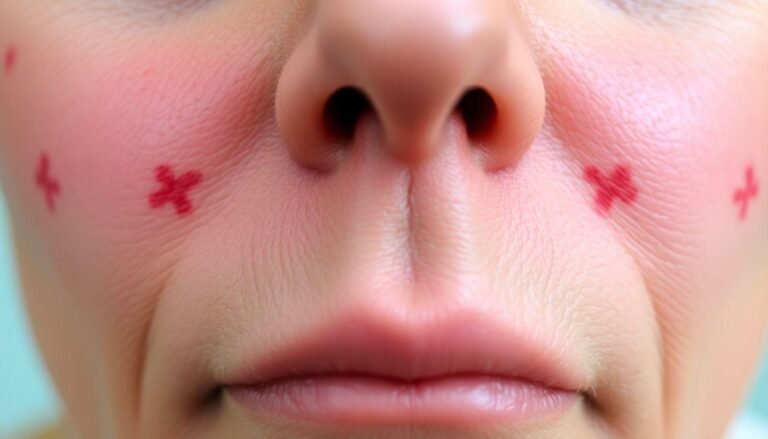Your skin tells a story—one that reveals far more than just your age or how well you’re sleeping. As your body’s largest organ, skin acts as a window into your overall health, displaying subtle and sometimes obvious signs of what’s happening internally. From unexpected rashes to mysterious discolorations, these skin pictures that reveal health secrets can provide early warnings of conditions ranging from minor nutritional deficiencies to serious systemic diseases. Being able to recognize these visual cues might just save you from overlooking important health signals your body is sending. Let’s explore ten telling skin images that health professionals use to identify underlying conditions—some might surprise you!
1. The Butterfly Rash of Lupus
One of the most distinctive skin manifestations in medicine is the butterfly-shaped rash that spreads across both cheeks and the bridge of the nose. This reddish, sometimes scaly rash resembles a butterfly with open wings and is a classic sign of systemic lupus erythematosus (SLE), an autoimmune disease.
What makes this rash particularly telling is its symmetry and location. Unlike common redness from sun exposure, the butterfly rash:
If you notice this distinctive pattern, especially if it persists for days, it’s worth consulting a healthcare provider promptly.
2. Yellow Skin and Eye Discoloration
Have you ever noticed someone’s skin or eyes taking on a yellowish tint? This condition, called jaundice, occurs when bilirubin (a yellow pigment formed during the normal breakdown of red blood cells) builds up in the tissues.
Jaundice most commonly suggests liver problems, but can also indicate issues with the gallbladder or pancreas. The yellowing typically appears first in the whites of the eyes before spreading to the face and body. This visual clue has been helping doctors diagnose liver conditions for centuries and remains one of the most reliable external signs of internal distress.
3. Dark Velvety Patches Signaling Insulin Resistance
Acanthosis Nigricans: The Diabetes Warning Sign
Those dark, velvety patches that sometimes appear on the neck, armpits, or groin area aren’t just a skin discoloration—they’re often a visual indicator of insulin resistance. Called acanthosis nigricans, these patches can be one of the earliest visible signs of pre-diabetes or type 2 diabetes.
The skin thickens and darkens in these areas because high insulin levels in the bloodstream affect skin cell growth. What’s fascinating is that this skin change can appear years before blood sugar levels become abnormal—giving you a valuable early warning system if you know what to look for.
4. Tiny Red Dots That Shouldn’t Be Ignored
Those tiny, pinpoint red dots that sometimes appear on your skin—medically known as petechiae—aren’t always just random spots. When they show up in clusters, especially on your lower legs, they might indicate a blood platelet deficiency or problems with blood vessel integrity.
Unlike regular bruises, petechiae don’t fade when pressed and are typically smaller (1-2mm). They can signal conditions ranging from vitamin deficiencies to more serious issues like leukemia or infections affecting the blood. Their appearance, especially when sudden or widespread, warrants medical attention.
5. The Telltale Signs in Your Nails
Your fingernails and toenails can reveal surprising health secrets. Nail changes often develop slowly, making them excellent indicators of long-term health patterns:
Clubbing: More Than Just Rounded Nails
When fingertips enlarge and nails curve downward, creating a rounded, club-like appearance, it’s called clubbing. This distinctive change often indicates lung diseases, cardiovascular problems, or liver conditions where oxygen in the blood is chronically low.
Beau’s Lines: Horizontal Depressions
These horizontal indentations across the nails often appear after a serious illness, intense stress, or severe injury—essentially marking the period when your body temporarily slowed nail growth. Think of them as growth rings that chronicle your health history.
6. Disappearing Eyebrow Edges
Have you noticed the outer third of your eyebrows thinning or disappearing altogether? This subtle but distinctive sign, known as Hertoghe’s sign, often indicates an underactive thyroid (hypothyroidism).
The connection might seem strange, but thyroid hormones play a crucial role in hair growth cycles. When these hormones are insufficient, hair in certain areas—particularly the outer eyebrows—stops growing properly. This visual clue often appears alongside other symptoms like fatigue, cold intolerance, and unintentional weight gain.
7. The Purple-Blue Rash of Dermatomyositis
A distinctive purplish-blue rash on the eyelids, accompanied by a similar rash on the knuckles, might be more than an unusual skin condition. This combination, known as heliotrope rash (on eyelids) and Gottron’s papules (on knuckles), is characteristic of dermatomyositis—an inflammatory muscle disease.
The rash gets its unusual color from inflammation in the blood vessels beneath the skin. What’s particularly important about recognizing this pattern is that dermatomyositis can sometimes be associated with underlying malignancies, making early detection especially valuable.
8. Unusual Skin Tags and Creases
While ordinary skin tags are common and harmless, an unusual number appearing suddenly might indicate insulin resistance or polycystic ovary syndrome.
Similarly, a diagonal crease across your earlobe (known as Frank’s sign) has been correlated with increased risk of coronary artery disease. Though not a definitive diagnostic tool, this unusual marking has sparked enough research interest to suggest it might be worth mentioning to your doctor during checkups.
9. The Butterfly of Rosacea vs. The Butterfly of Lupus
Both lupus and rosacea can cause redness across the central face, but distinguishing between them is crucial:
Rosacea typically involves:
Unlike the butterfly rash of lupus, rosacea doesn’t usually involve systemic symptoms like joint pain or fever, and it tends to fluctuate rather than remain constant.
10. White Spots and Patches: Vitiligo’s Story
The appearance of white patches on the skin, known as vitiligo, occurs when pigment-producing cells die or stop functioning. While vitiligo itself isn’t physically harmful, it can be associated with other autoimmune conditions like thyroid disorders, Addison’s disease, or pernicious anemia.
Beyond its potential connections to other conditions, vitiligo serves as a reminder of how skin changes can affect psychological well-being—highlighting the importance of both physical and emotional support in dermatological care.
Understanding Your Skin’s Messages
Your skin constantly communicates important information about your overall health. By becoming familiar with these skin pictures that reveal health secrets, you gain valuable insight into potential underlying conditions that might otherwise go undetected until more serious symptoms develop.
Remember that while these visual cues provide important clues, they should always be evaluated by healthcare professionals for proper diagnosis and treatment. Your skin’s appearance is just one piece of your health puzzle—but it’s often the most visible one, offering vital early warnings when you know what to look for.







